Kinetic Aspects of the Interactions between TiO2 Nanoparticles, Mercury and the Green Alga Chlamydomonas reinhardtii
Abstract
:1. Introduction
2. Materials and Methods
2.1. Chemicals
2.2. Algal Cell Growth
2.3. Experimental Design
2.4. Determination of Hg Adsorption on nTiO2
2.5. Physicochemical Characterization of nTiO2
2.6. Determination of Hg Availability to Algae
3. Results and Discussion
3.1. Adsorption Kinetics of Hg on nTiO2
3.2. Time Course of Aggregation of nTiO2 and Hg-nTiO2 Complexes
3.3. Kinetics of Sedimentation of nTiO2 and Hg-nTiO2 Complexes
3.4. Kinetics of Hg Uptake by C. reinhardtii in Mixtures with nTiO2
4. Conclusions
Author Contributions
Funding
Institutional Review Board Statement
Informed Consent Statement
Data Availability Statement
Conflicts of Interest
References
- Li, M.T.; Liu, W.; Slaveykova, V.I. Effects of mixtures of engineered nanoparticles and metallic pollutants on aquatic organisms. Environments 2020, 7, 27. [Google Scholar] [CrossRef] [Green Version]
- Naasz, S.; Altenburger, R.; Kühnel, D. Environmental mixtures of nanomaterials and chemicals: The trojan-horse phenomenon and its relevance for ecotoxicity. Sci. Total Environ. 2018, 635, 1170–1181. [Google Scholar] [CrossRef] [PubMed]
- Auffan, M.; Rose, J.; Bottero, J.Y.; Lowry, G.V.; Jolivet, J.P.; Wiesner, M.R. Towards a definition of inorganic nanoparticles from an environmental, health and safety perspective. Nat. Nanotechnol. 2009, 4, 634–641. [Google Scholar] [CrossRef] [PubMed]
- Handy, R.D.; von der Kammer, F.; Lead, J.R.; Hassellov, M.; Owen, R.; Crane, M. The ecotoxicology and chemistry of manufactured nanoparticles. Ecotoxicology 2008, 17, 287–314. [Google Scholar] [CrossRef] [PubMed]
- Slaveykova, V.I.; Li, M.T.; Worms, I.A.; Liu, W. When environmental chemistry meets ecotoxicology: Bioavailability of inorganic nanoparticles to phytoplankton. Chimia 2020, 74, 115–121. [Google Scholar] [CrossRef] [PubMed]
- Chen, F.; Wu, L.; Xiao, X.; Rong, L.; Li, M.; Zou, X. Mixture toxicity of zinc oxide nanoparticle and chemicals with different mode of action upon Vibrio Fischeri. Environ. Sci. 2020, 32, 41. [Google Scholar] [CrossRef]
- Wang, D.; Hu, J.; Irons, D.R.; Wang, J. Synergistic toxic effect of nano-TiO2 and As (V) on Ceriodaphnia dubia. Sci. Total Environ. 2011, 409, 1351–1356. [Google Scholar] [CrossRef]
- Singh, J.; Lee, B.-K. Influence of nano-TiO2 particles on the bioaccumulation of cd in soybean plants (Glycine max): A possible mechanism for the removal of cd from the contaminated soil. J. Environ. Manag. 2016, 170, 88–96. [Google Scholar] [CrossRef]
- Li, M.; Slaveykova, V.I. Dual role of titanium dioxide nanoparticles in the accumulation of inorganic and methyl mercury by crustacean Daphnia magna through waterborne and dietary exposure. Environ. Pollut. 2022, 295, 118619. [Google Scholar] [CrossRef]
- Li, M.; Liu, W.; Slaveykova, V.I. NanoTiO2 materials mitigate mercury uptake and effects on green alga chlamydomonas reinhardtii in mixture exposure. Aquat. Toxicol. 2020, 224, 105502. [Google Scholar] [CrossRef]
- Yu, Z.; Hao, R.; Zhang, L.; Zhu, Y. Effects of TiO2, SiO2, Ag and CdTe/CdSquantum dots nanoparticles on toxicity of cadmium towards Chlamydomonas reinhardtii. Ecotoxicol. Environ. Saf. 2018, 156, 75–86. [Google Scholar] [CrossRef] [PubMed]
- Li, X.; Ma, Q.; Liu, T.; Dong, Z.; Fan, W. Effect of TiO2-nanoparticles on copper toxicity to bacteria: Role of bacterial surface. RSC Adv. 2020, 10, 5058–5065. [Google Scholar] [CrossRef] [Green Version]
- Fan, W.; Liang, D.; Wang, X.; Ren, J.; Xiao, S.; Zhou, T. Two-generational effects and recovery of arsenic and arsenate on Daphnia magna in the presence of nano-TiO2. Ecotoxicol. Environ. Saf. 2019, 172, 136–143. [Google Scholar] [CrossRef]
- Yi, X.; Chi, T.; Liu, B.; Liu, C.; Feng, G.; Dai, X.; Zhang, K.; Zhou, H. Effect of nano zinc oxide on the acute and reproductive toxicity of cadmium and lead to the marine copepod Tigriopus japonicus. Comp. Biochem. Physiol. Part C Toxicol. Pharmacol. 2019, 222, 118–124. [Google Scholar] [CrossRef] [PubMed]
- Sharma, V.K. Aggregation and toxicity of titanium dioxide nanoparticles in aquatic environment—A review. J. Environ. Sci. Health Part A 2009, 44, 1485–1495. [Google Scholar] [CrossRef] [PubMed]
- Keller, A.A.; Lazareva, A. Predicted releases of engineered nanomaterials: From global to regional to local. Environ. Sci. Technol. Lett. 2014, 1, 65–70. [Google Scholar] [CrossRef] [Green Version]
- Zhang, J.; Li, L.; Li, Y.; Yang, C. Microwave-assisted synthesis of hierarchical mesoporous nano-TiO2/cellulose composites for rapid adsorption of Pb2+. Chem. Eng. J. 2017, 313, 1132–1141. [Google Scholar] [CrossRef]
- Kuang, X.; Shao, J.; Peng, L.; Song, H.; Wei, X.; Luo, S.; Gu, J.-d. Nano-TiO2 enhances the adsorption of Cd(II) on biological soil crusts under mildly acidic conditions. J. Contam. Hydrol. 2020, 229, 103583. [Google Scholar] [CrossRef]
- Driscoll, C.T.; Mason, R.P.; Chan, H.M.; Jacob, D.J.; Pirrone, N. Mercury as a global pollutant: Sources, pathways, and effects. Environ. Sci. Technol. 2013, 47, 4967–4983. [Google Scholar] [CrossRef]
- Yang, L.; Zhang, Y.; Wang, F.; Luo, Z.; Guo, S.; Strähle, U. Toxicity of mercury: Molecular evidence. Chemosphere 2020, 245, 125586. [Google Scholar] [CrossRef]
- Le Faucheur, S.; Campbell, P.G.C.; Fortin, C.; Slaveykova, V.I. Interactions between mercury and phytoplankton: Speciation, bioavailability, and internal handling. Environ. Toxicol. Chem. 2014, 33, 1211–1224. [Google Scholar] [CrossRef] [PubMed]
- Dranguet, P.; Flück, R.; Regier, N.; Cosio, C.; Le Faucheur, S.; Slaveykova, V.I. Towards mechanistic understanding of mercury availability and toxicity to aquatic primary producers. Chimia 2014, 68, 799–805. [Google Scholar] [CrossRef] [PubMed] [Green Version]
- Cosio, C.; Flück, R.; Regier, N.; Slaveykova, V.I. Effects of macrophytes on the fate of mercury in aquatic systems. Environ. Toxicol. Chem. 2014, 33, 1225–1237. [Google Scholar] [CrossRef]
- Beauvais-Flück, R.; Slaveykova, V.I.; Cosio, C. Molecular effects of inorganic and methyl mercury in aquatic primary producers: Comparing impact to a macrophyte and a green microalga in controlled conditions. Geosciences 2018, 8, 393. [Google Scholar] [CrossRef] [Green Version]
- Harris, E.H. The Chlamydomonas Sourcebook: A Comprehensive Guide to Biology and Laboratory Use; Elsevier: Amsterdam, The Netherlands, 2013. [Google Scholar]
- Kahru, A.; Ivask, A. Mapping the dawn of nanoecotoxicological research. Acc. Chem. Res. 2013, 46, 823–833. [Google Scholar] [CrossRef] [PubMed]
- Brunelli, A.; Pojana, G.; Callegaro, S.; Marcomini, A. Agglomeration and sedimentation of titanium dioxide nanoparticles (n-TiO2) in synthetic and real waters. J. Nanoparticle Res. 2013, 15, 1684. [Google Scholar] [CrossRef]
- Li, M.; Slaveykova, V.I. A density gradient centrifugation method for rapid separation of nanoTiO2 and TiO2 aggregates from microalgal cells in complex mixtures with mercury. MethodsX 2020, 7, 101057. [Google Scholar] [CrossRef] [PubMed]
- Beauvais-Flück, R.; Slaveykova, V.I.; Cosio, C. Transcriptomic and physiological responses of the green microalga Chlamydomonas reinhardtii during short-term exposure to subnanomolar methylmercury concentrations. Environ. Sci. Technol. 2016, 50, 7126–7134. [Google Scholar] [CrossRef]
- Beauvais-Flück, R.; Slaveykova, V.I.; Cosio, C. Cellular toxicity pathways of inorganic and methyl mercury in the green microalga Chlamydomonas reinhardtii. Sci. Rep. 2017, 7, 8034. [Google Scholar] [CrossRef] [Green Version]
- Lopez-Munoz, M.J.; Arencibia, A.; Cerro, L.; Pascual, R.; Melgar, A. Adsorption of Hg(II) from aqueous solutions using TiO2 and titanate nanotube adsorbents. Appl. Surf. Sci. 2016, 367, 91–100. [Google Scholar] [CrossRef]
- Keller, A.A.; Wang, H.; Zhou, D.; Lenihan, H.S.; Cherr, G.; Cardinale, B.J.; Miller, R.; Ji, Z. Stability and aggregation of metal oxide nanoparticles in natural aqueous matrices. Environ. Sci. Technol. 2010, 44, 1962–1967. [Google Scholar] [CrossRef] [PubMed]
- Mandzy, N.; Grulke, E.; Druffel, T. Breakage of TiO2 agglomerates in electrostatically stabilized aqueous dispersions. Powder Technol. 2005, 160, 121–126. [Google Scholar] [CrossRef]
- Mahdavi, S. Nano-TiO2 modified with natural and chemical compounds as efficient adsorbents for the removal of Cd+ 2, Cu+ 2, and Ni+ 2 from water. Clean Technol. Environ. Policy 2016, 18, 81–94. [Google Scholar] [CrossRef]
- Han, Z.-X.; He, G.-D.; Wang, J.-H.; Lv, C.-x. Interaction influence of cd (ii) and nano-TiO2 on aggregation and adsorption kinetics toward marine algae. Int. J. Green Nanotechnol. 2011, 3, 229–237. [Google Scholar] [CrossRef]
- Wu, Y.; Wang, W.-X. Accumulation, subcellular distribution and toxicity of inorganic mercury and methylmercury in marine phytoplankton. Environ. Pollut. 2011, 159, 3097–3105. [Google Scholar] [CrossRef]
- Morelli, E.; Ferrara, R.; Bellini, B.; Dini, F.; Di Giuseppe, G.; Fantozzi, L. Changes in the non-protein thiol pool and production of dissolved gaseous mercury in the marine diatom Thalassiosira weissflogii under mercury exposure. Sci. Total Environ. 2009, 408, 286–293. [Google Scholar] [CrossRef] [Green Version]
- Huang, C.; Cha, D.; Ismat, S. Progress Report: Short-Term Chronic Toxicity of Photocatalytic Nanoparticles to Bacteria, Algae, and Zooplankton; University of Delaware: Newark, NJ, USA, 2005. [Google Scholar]
- Yang, W.-W.; Wang, Y.; Huang, B.; Wang, N.-X.; Wei, Z.-B.; Luo, J.; Miao, A.-J.; Yang, L.-Y. TiO2 nanoparticles act as a carrier of cd bioaccumulation in the ciliate Tetrahymena thermophila. Environ. Sci. Technol. 2014, 48, 7568–7575. [Google Scholar] [CrossRef]
- Tan, L.-Y.; Huang, B.; Xu, S.; Wei, Z.-B.; Yang, L.-Y.; Miao, A.-J. Aggregation reverses the carrier effects of TiO2 nanoparticles on cadmium accumulation in the waterflea Daphnia magna. Environ. Sci. Technol. 2017, 51, 932–939. [Google Scholar] [CrossRef]
- He, X.; Xie, C.; Ma, Y.; Wang, L.; He, X.; Shi, W.; Liu, X.; Liu, Y.; Zhang, Z. Size-dependent toxicity of tho2 nanoparticles to green algae Chlorella pyrenoidosa. Aquat. Toxicol. 2019, 209, 113–120. [Google Scholar] [CrossRef]
- Kola, H.; Wilkinson, K.J. Cadmium uptake by a green alga can be predicted by equilibrium modelling. Environ. Sci. Technol. 2005, 39, 3040–3047. [Google Scholar] [CrossRef]
- Worms, I.A.; Wilkinson, K.J. Ni uptake by a green alga. 2. Validation of equilibrium models for competition effects. Environ. Sci. Technol. 2007, 41, 4264–4270. [Google Scholar] [CrossRef] [PubMed]
- Slaveykova, V.I.; Wilkinson, K.J. Physicochemical Aspects of Lead Bioaccumulation by Chlorella vulgaris. Environ. Sci. Technol. 2002, 36, 969–975. [Google Scholar] [CrossRef] [PubMed] [Green Version]
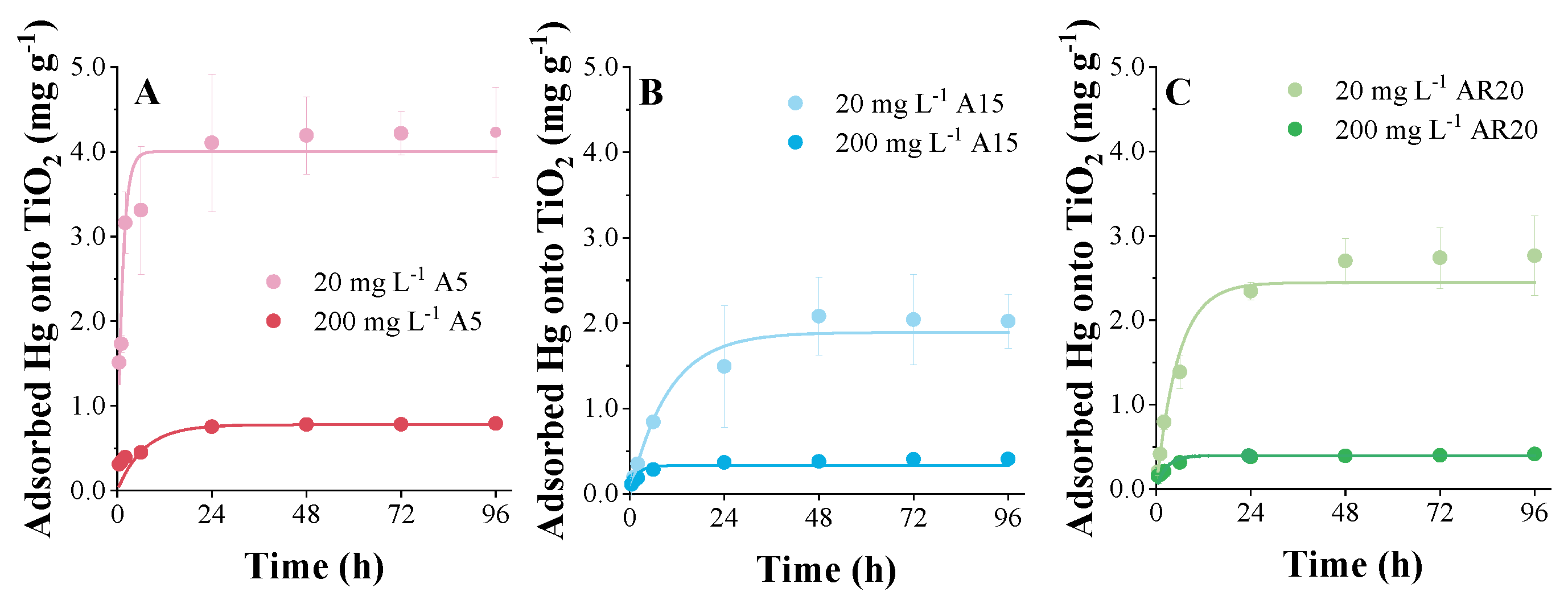
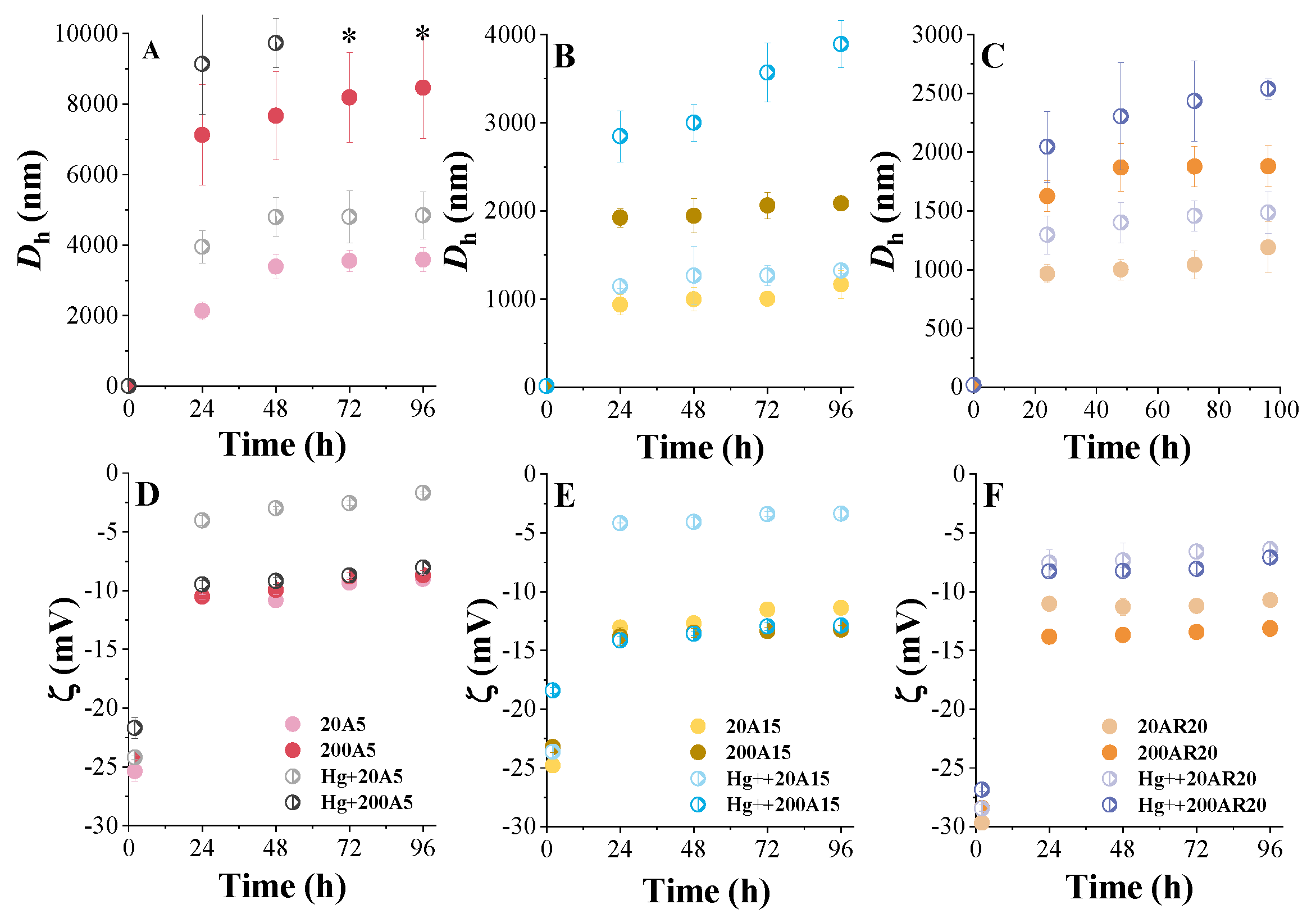
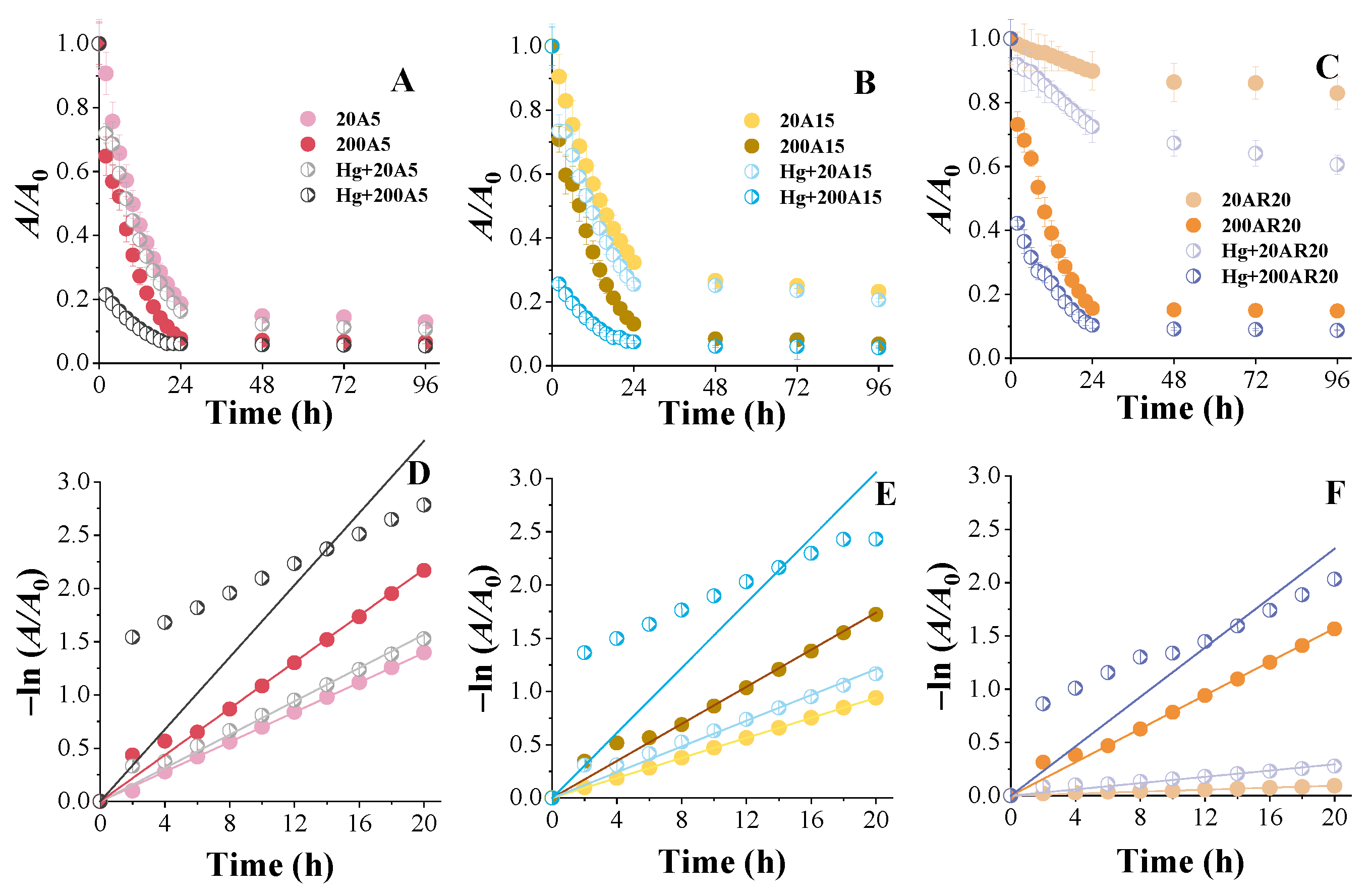
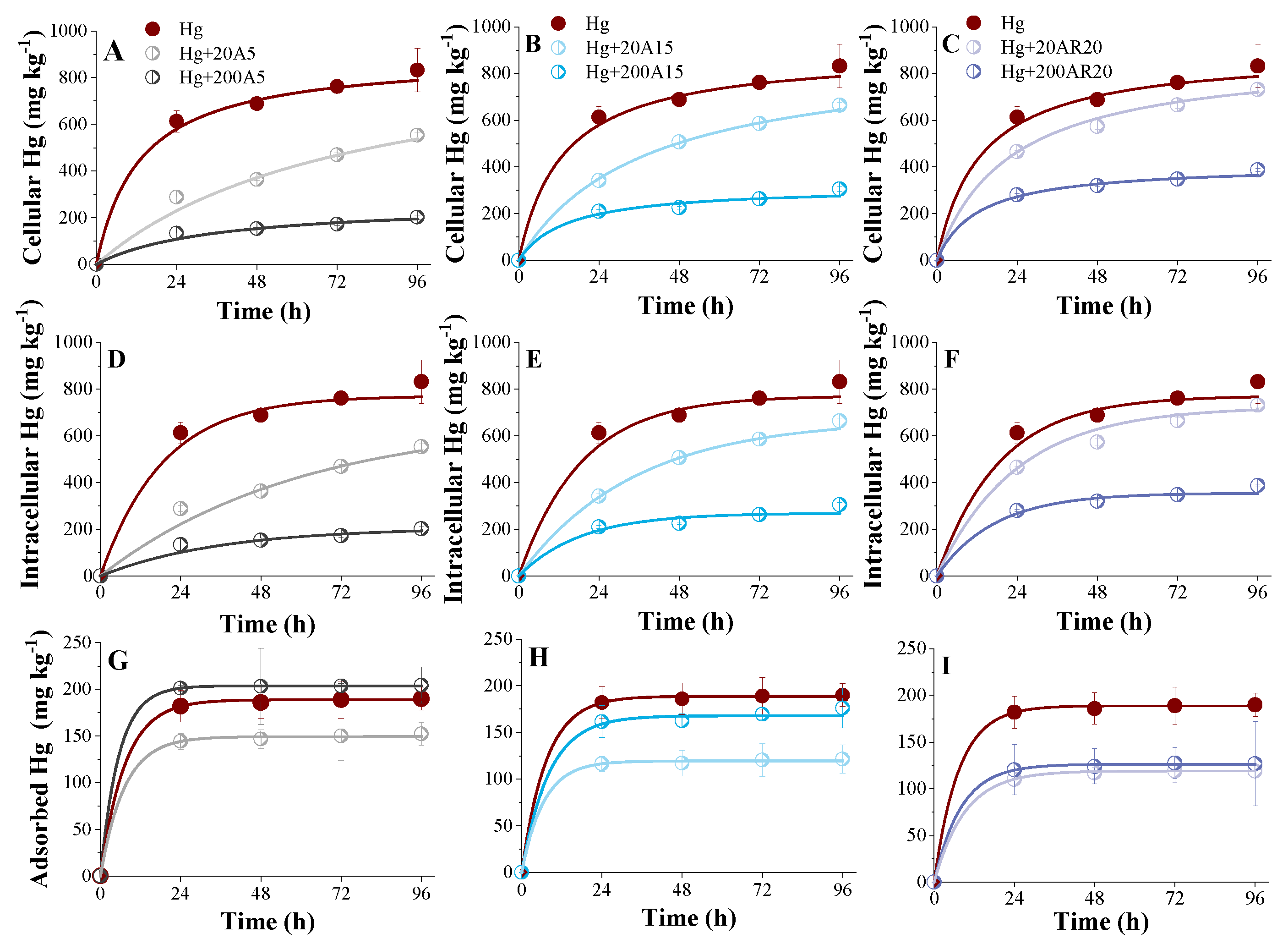
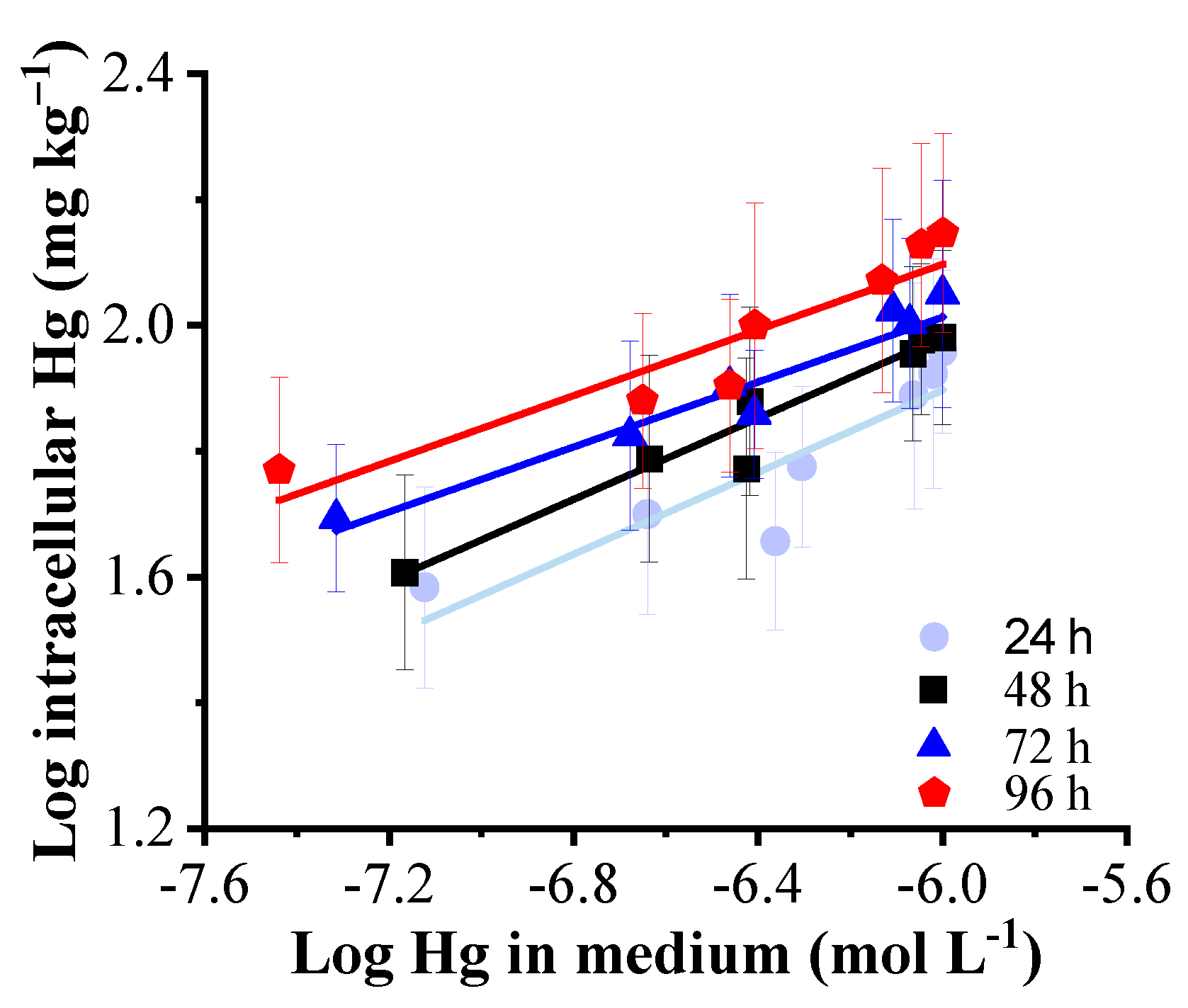
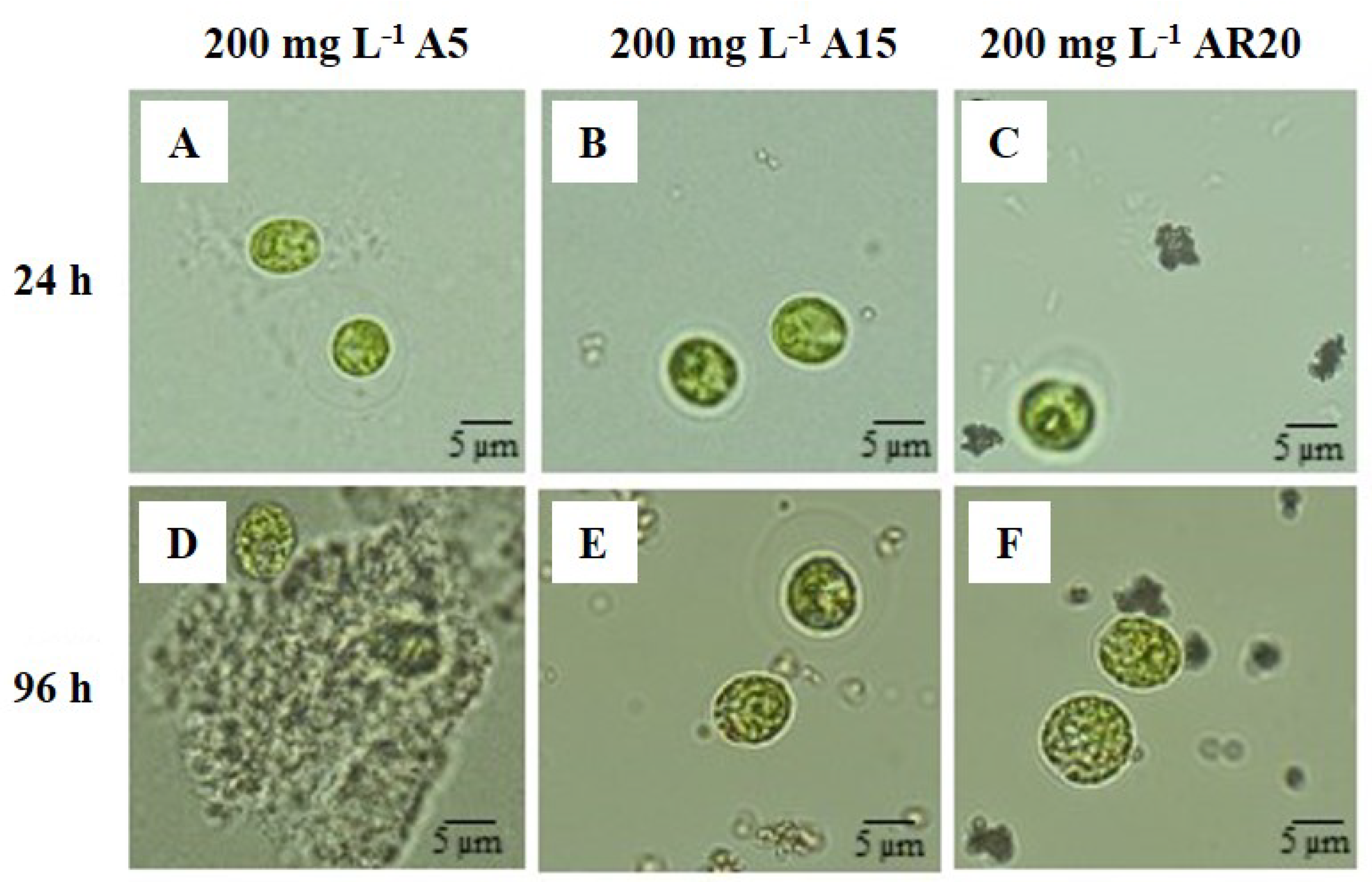
| Parameter | Hg | Hg + 20 mg L−1 A5 | Hg + 200 mg L−1 A5 | Hg + 20 mg L−1 A15 | Hg + 200 mg L−1 A15 | Hg + 20 mg L−1 AR20 | Hg + 200 mg L−1 AR20 | |
|---|---|---|---|---|---|---|---|---|
| Hg adsorption on nTiO2 | ||||||||
| kads,nTiO2 * | ×102 L kg−1 h−1 | - | 26.58 ± 4.25 | 2.89 ± 2.21 | 3.27 ± 0.63 | 1.85 ± 0.25 | 1.46 ± 0.25 | 1.31 ± 0.05 |
| kdes,nTiO2 | ×10−1 h−1 | - | 7.30 ± 2.70 | 4.10 ± 0.60 | 1.29 ± 0.01 | 5.10 ± 1.25 | 0.79 ± 0.19 | 3.56 ± 0.42 |
| R2 | - | 0.82 | 0.86 | 0.99 | 0.92 | 0.99 | 0.94 | |
| Hg adsorption on algae | ||||||||
| kads * | ×102 L kg−1 h−1 | 1.42 ± 0.15 | 1.10 ± 0.14 | 1.99 ± 0.09 | 0.96 ± 0.37 | 0.50 ± 0.26 | 0.71 ± 0.02 | 0.87 ± 0.07 |
| kads ** | ×10−2 h−1 | 3.55 ± 0.29 | 2.75 ± 0.34 | 4.98 ± 0.23 | 2.40 | 1.26 ± 0.54 | 1.76 ± 0.06 | 2.17 ± 0.15 |
| kdes | ×10−1 h−1 | 1.39 ± 0.12 | 1.35 ± 0.18 | 1.80 ± 0.08 | 1.48 ± 0.25 | 0.44 ± 0.26 | 1.09 ± 0.05 | 1.26 ± 0.12 |
| R2 | 0.99 | 0.99 | 1.00 | 1.00 | 0.88 | 1.00 | 1.00 | |
| Hg internalization | ||||||||
| kint * | ×102 L kg−1 h−1 | 2.42 ± 0.36 | 0.73 ± 0.11 | 0.45 ± 0.08 | 1.02 ± 0.05 | 0.71 ± 0.12 | 1.52 ± 0.17 | 1.10 ± 0.16 |
| kint ** | ×10−2 h−1 | 6.04 ± 0.89 | 1.83 ± 0.27 | 1.13 ± 0.22 | 2.55 ± 0.12 | 1.79 ± 0.40 | 3.81 ± 0.41 | 2.75 ± 0.41 |
| kef | ×10−2 h−1 | 5.62 ± 1.06 | 2.23 ± 0.58 | 4.36 ± 1.13 | 2.66 ± 0.20 | 4.61 ± 0.14 | 3.88 ± 0.60 | 5.52 ± 1.05 |
| R2 | 0.98 | 0.98 | 0.97 | 0.99 | 0.96 | 0.99 | 0.98 | |
| Treatment | Sedimentation | ||||
|---|---|---|---|---|---|
| ksettle (h−1) * | R2 | Treatment | ksettle (h−1) * | R2 | |
| 20A5 | 4.2 | 0.96 | Hg + 20A5 | 4.6 | 0.98 |
| 200A5 | 6.5 | 0.95 | Hg + 200A5 | 9.0 | 0.94 |
| 20A15 | 2.8 | 0.97 | Hg + 20A15 | 3.5 | 0.97 |
| 200A15 | 5.2 | 0.96 | Hg + 200A15 | 8.2 | 0.93 |
| 20AR20 | 0.3 | 0.98 | Hg + 20AR20 | 0.9 | 0.98 |
| 200AR20 | 4.7 | 0.98 | Hg + 200AR20 | 6.5 | 0.93 |
Publisher’s Note: MDPI stays neutral with regard to jurisdictional claims in published maps and institutional affiliations. |
© 2022 by the authors. Licensee MDPI, Basel, Switzerland. This article is an open access article distributed under the terms and conditions of the Creative Commons Attribution (CC BY) license (https://creativecommons.org/licenses/by/4.0/).
Share and Cite
Li, M.; Slaveykova, V.I. Kinetic Aspects of the Interactions between TiO2 Nanoparticles, Mercury and the Green Alga Chlamydomonas reinhardtii. Environments 2022, 9, 44. https://doi.org/10.3390/environments9040044
Li M, Slaveykova VI. Kinetic Aspects of the Interactions between TiO2 Nanoparticles, Mercury and the Green Alga Chlamydomonas reinhardtii. Environments. 2022; 9(4):44. https://doi.org/10.3390/environments9040044
Chicago/Turabian StyleLi, Mengting, and Vera I. Slaveykova. 2022. "Kinetic Aspects of the Interactions between TiO2 Nanoparticles, Mercury and the Green Alga Chlamydomonas reinhardtii" Environments 9, no. 4: 44. https://doi.org/10.3390/environments9040044
APA StyleLi, M., & Slaveykova, V. I. (2022). Kinetic Aspects of the Interactions between TiO2 Nanoparticles, Mercury and the Green Alga Chlamydomonas reinhardtii. Environments, 9(4), 44. https://doi.org/10.3390/environments9040044






